Quintet of techniques optimizes glued IOL surgery
This method is especially useful in eyes with larger white-to-white diameters.
The terminology “quintet” comprises five different techniques that are performed in sequential order to optimize the results of glued IOL surgery. This is specially indicated in cases with greater white-to-white diameter because these eyes are large and need a special set of techniques to be adopted for successful intrascleral haptic fixation due to the limitation imposed by the overall length of a three-piece IOL.
The first technique employed is vertical glued fixation wherein two partial-thickness scleral flaps are made at the 12 and 6 o’clock positions about 180° opposite to each other (Figure 1). The concept behind making vertical flaps is that the vertical diameter of the cornea is less than the horizontal diameter. So the haptics have to cover a shorter distance for externalization, thereby facilitating a greater amount of haptic tuck into the intrascleral pockets.
The second method employed is the introduction of infusion with a trocar anterior chamber maintainer (T-ACM) that allows continuous maintenance of the globe without encroaching upon the surface of cornea, thereby leaving the entire working space in complicated surgeries at the disposal of the operating surgeon. The T-ACM is introduced about 0.5 mm away from the limbus in a biplanar fashion in a way that it enters the eye in front of the iris tissue. Alternatively, an anterior chamber maintainer or a trocar infusion at the pars plana (Figure 2) can also be employed.
The third technique is performing a peripheral iridectomy at the proposed sclerotomy site with the help of a vitrector set at 20 cuts/minute and low vacuum settings (Figure 3). This step is performed because in large eyes it is advised to carry out anterior sclerotomy. But while doing so, the peripheral iris tissue often gets disengaged from the iris root or hyphema may be encountered. To prevent this dragging of iris tissue while performing anterior sclerotomy, a peripheral iridectomy is performed so that it ensures smooth passage of the needle and forceps from the sclerotomy site without damaging the iris tissue as it is already cut.

Images: Narang P, Agarwal A
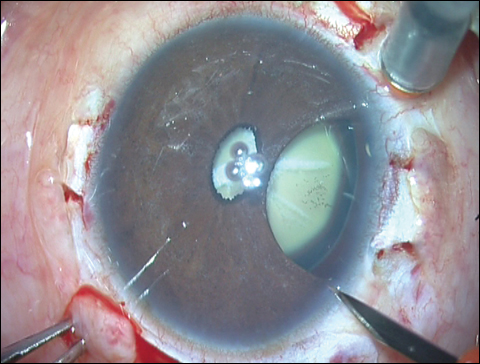
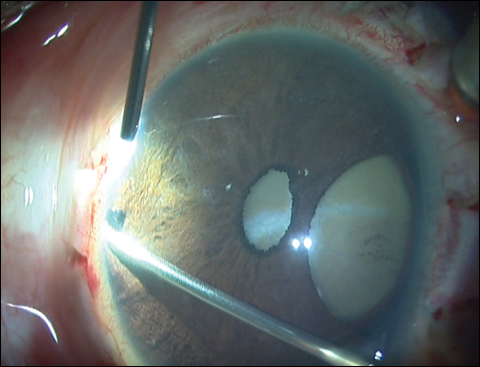
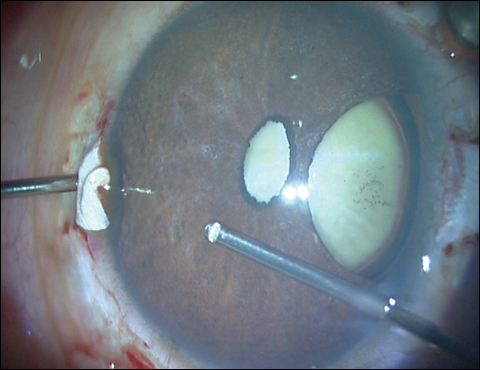
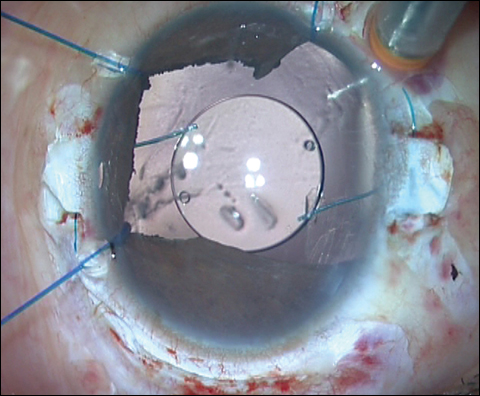
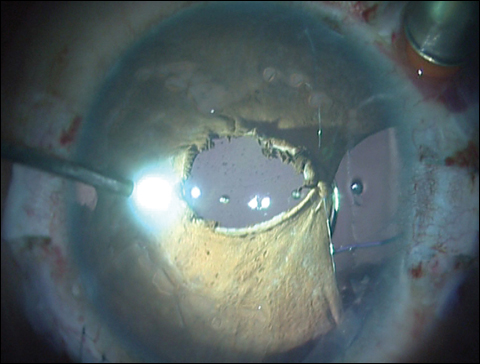
The fourth part of the quintet is anterior sclerotomy that is performed at a distance of 0.5 mm away from the limbus beneath the scleral flaps (Figure 4). After this, the glued IOL procedure is performed, and both the haptics are externalized (Figure 5) and tucked into the scleral pockets.
The fifth component of the quintet is performing pupilloplasty (Figure 6) with the reasoning that due to the anterior sclerotomy there is an anterior shift of the plane of the IOL, and this can lead to optic capture. Pupilloplasty is therefore performed with the intention of narrowing down the pupil size to 5 mm so that it is less than the optic diameter, thereby negating any chances of optic capture.
- For more information:
- Amar Agarwal, MS, FRCS, FRCOphth, is director of Dr. Agarwal’s Eye Hospital and Eye Research Centre. Agarwal is the author of several books published by SLACK Incorporated, publisher of Ocular Surgery News, including Phaco Nightmares: Conquering Cataract Catastrophes, Bimanual Phaco: Mastering the Phakonit/MICS Technique, Dry Eye: A Practical Guide to Ocular Surface Disorders and Stem Cell Surgery and Presbyopia: A Surgical Textbook. He can be reached at 19 Cathedral Road, Chennai 600 086, India; email: dragarwal@vsnl.com; website: www.dragarwal.com.
- Priya Narang, MS, is the director of Narang Eye Care & Laser Centre, Ahmedabad, India. She can be reached at email: narangpriya19@gmail.com.
Disclosure: The authors report no relevant financial disclosures.
